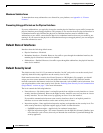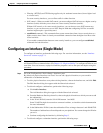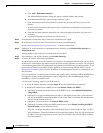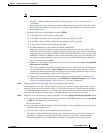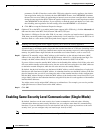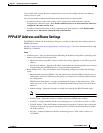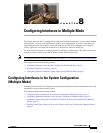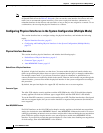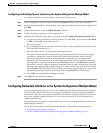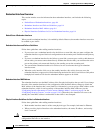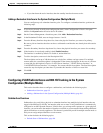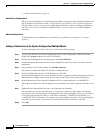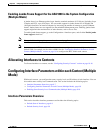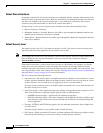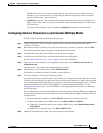
8-2
Cisco ASDM User Guide
OL-16647-01
Chapter 8 Configuring Interfaces in Multiple Mode
Configuring Interfaces in the System Configuration (Multiple Mode)
Note If you use failover, you need to assign a dedicated interface as the failover link and an optional interface
for Stateful Failover on the Failover: Setup tab. (You can use the same interface for failover and state
traffic, but we recommend separate interfaces). You can use a physical interface, subinterface, or
redundant interface for the failover and state links, as long as they are not assigned to a context. To use
a subinterface, do not assign the physical interface to a context.
Configuring Physical Interfaces in the System Configuration (Multiple Mode)
This section describes how to configure settings for physical interfaces, and includes the following
topics:
• Physical Interface Overview, page 8-2
• Configuring and Enabling Physical Interfaces in the System Configuration (Multiple Mode),
page 8-3
Physical Interface Overview
This section describes physical interfaces, and includes the following topics:
• Default State of Physical Interfaces, page 8-2
• Connector Types, page 8-2
• Auto-MDI/MDIX Feature, page 8-2
Default State of Physical Interfaces
By default, all physical interfaces are shut down. You must enable the physical interface before any
traffic can pass through it (either alone or as part of a redundant interface pair), or through a subinterface.
For multiple context mode, if you allocate an interface (physical, redundant, or subinterface) to a
context, the interfaces are enabled by default in the context. However, before traffic can pass through the
context interface, you must first enable the physical interface in the system configuration according to
this procedure.
By default, the speed and duplex for copper (RJ-45) interfaces are set to auto-negotiate.
Connector Types
The ASA 5550 adaptive security appliance and the 4GE SSM for the ASA 5510 and higher adaptive
security appliance include two connector types: copper RJ-45 and fiber SFP. RJ-45 is the default.
To use the fiber SFP connectors, you must set the media type to SFP. The fiber interface has a fixed speed
and does not support duplex, but you can set the interface to negotiate link parameters (the default) or
not to negotiate.
Auto-MDI/MDIX Feature
For RJ-45 interfaces on the ASA 5500 series adaptive security appliance, the default auto-negotiation
setting also includes the Auto-MDI/MDIX feature. Auto-MDI/MDIX eliminates the need for crossover
cabling by performing an internal crossover when a straight cable is detected during the auto-negotiation
phase. Either the speed or duplex must be set to auto-negotiate to enable Auto-MDI/MDIX for the
interface. If you explicitly set both the speed and duplex to a fixed value, thus disabling auto-negotiation
for both settings, then Auto-MDI/MDIX is also disabled.



